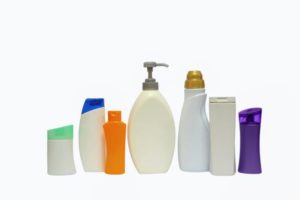 More bad news about BPA (bisphenol A) - an endocrine disrupter linked to a number of health problems, including reproductive disorders (here, here, and here). A new study has lent support for a link between bisphenol A (BPA) exposure during pregnancy and later breast cancer. BPA can cross the placenta in the womb, and so expose the fetus, it has been found in placental tissue, and newborns can be exposed through breastfeeding. BPA is found in the urine of about 95% of the U.S. population.
More bad news about BPA (bisphenol A) - an endocrine disrupter linked to a number of health problems, including reproductive disorders (here, here, and here). A new study has lent support for a link between bisphenol A (BPA) exposure during pregnancy and later breast cancer. BPA can cross the placenta in the womb, and so expose the fetus, it has been found in placental tissue, and newborns can be exposed through breastfeeding. BPA is found in the urine of about 95% of the U.S. population.
It's hard to avoid BPA because it's found in so many products, but a person can lower exposure to it by avoiding canned products (it's in the can linings), as well as plastic bottles and containers, microwaving or heating food in plastic containers, and fast food (it's in the packaging and leaches into the food) . Glass and stainless steel is OK for storing food. By the way, BPA substitutes such as BPS and BPSIP have the same negative health effects (because they're chemically similar) - so also avoid "BPA-free" products. From Endocrine News;
A Pervasive Threat: The Danger of in utero BPA Exposure
A new study presented at ENDO [Endocrine Society] 2016 revealed a possible link between bisphenol A exposure in utero to breast cancer later in life. In the process, the researchers created a new bioassay that can test chemicals much faster than typical animal studies. Almost every single person alive today has detectable amounts of endocrine-disrupting chemicals (EDCs) in his or her body, according to the 2015 joint Endocrine Society/IPEN publication Introduction to Endocrine Disrupting Chemicals (EDCs): A Guide for Public Interest Organizations and Policy-Makers.
These EDCs — phthalates (plasticizers), bisphenol A (BPA), polychlorinated biphenyls (PCBs), and others, in their bodies — are hormone-like industrial chemicals that did not even exist 100 or so years ago. Studies on human populations consistently demonstrate associations between the presence of certain chemicals and higher risks of endocrine disorders such as impaired fertility, diabetes, obesity, cardiovascular disorders, and cancer.
The xenoestrogen BPA is especially prevalent as a component used in rigid plastic products such as compact discs, food and beverage containers, food and formula can linings, and glossy paper receipts. In the case of food containers, when they are heated or scratched, the BPA can seep out into the food and then be ingested. BPA also escapes from water pipes, dental materials, cosmetics, and household products among others and is released into the environment or directly consumed. According to research, such exposures help account for why BPA has been found in the urine of a representative sample of 95% of the U.S. population.
Notably, BPA can cross the placenta in the womb, indirectly exposing the fetus — it has been found in both maternal and fetal serum as well as neonatal placental tissue. Newborns can also be directly exposed through breastfeeding.
The results of a study presented at ENDO 2016 provide compelling support for the idea that fetal exposure to BPA might increase risk for development of breast cancer in adulthood; in fact, it may explain why overall incidence increased in the 20th century. Lucia Speroni, PhD, a research associate and member of the Soto-Sonnenschein lab at Tufts University School of Medicine in Boston and the study’s lead investigator, reports, “We found that BPA acts directly on the mammary gland and that this effect is dose dependent: A low dose significantly increased ductal growth, whereas a high dose decreased it.”
“Because these effects are similar to those found when exposing the fetus through its mother, our experiment suggests that BPA acts directly on the fetal mammary gland, causing changes to the tissue that have been associated with a higher predisposition to breast cancer later in life,” Speroni explains. In replicating the process of mammary gland development in vitro, this method additionally allows for live observation throughout the whole process.....The lab team had previously shown that the most harmful time for exposure to BPA is during fetal development by causing alterations in the developing mammary gland.

 Two recent articles about BPA (bisphenol A), BPS (bisphenol B), and the "BPA-free" label - one a study, and one a review article. The "BPA-free" label unfortunately means the product contains a product similar to BPA (typically BPS) and with the same problems as BPA. Both articles discuss the accumulating health reasons to try to avoid these endocrine disruptors. Which is really , really tough to do given that plastics are all around us and used by us every day.
Two recent articles about BPA (bisphenol A), BPS (bisphenol B), and the "BPA-free" label - one a study, and one a review article. The "BPA-free" label unfortunately means the product contains a product similar to BPA (typically BPS) and with the same problems as BPA. Both articles discuss the accumulating health reasons to try to avoid these endocrine disruptors. Which is really , really tough to do given that plastics are all around us and used by us every day. More and more studies are finding negative health effects from hormone disrupting chemicals (which we are exposed to every single day, and subsequently which are in all of us), such as parabens, phthalates, Bisphenol-A (BPA), and chemical substitutes for BPA such as Bisphenol-S (BPS) and BPF. The
More and more studies are finding negative health effects from hormone disrupting chemicals (which we are exposed to every single day, and subsequently which are in all of us), such as parabens, phthalates, Bisphenol-A (BPA), and chemical substitutes for BPA such as Bisphenol-S (BPS) and BPF. The